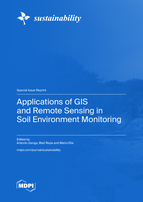Applications of GIS and Remote Sensing in Soil Environment Monitoring
A special issue of Sustainability (ISSN 2071-1050). This special issue belongs to the section "Soil Conservation and Sustainability".
Deadline for manuscript submissions: closed (15 July 2023) | Viewed by 26538
Special Issue Editors
Interests: soil science; regional planning; remote sensing; geostatistics
Special Issues, Collections and Topics in MDPI journals
Interests: geoinformatics (GIS); geography; cartography; soil science
Special Issues, Collections and Topics in MDPI journals
Interests: forest ecology; fire and fuel management; geospatial modelling
Special Issues, Collections and Topics in MDPI journals
Special Issue Information
Dear Colleagues,
The monitoring of environmental features is a key issue in the sustainable management of land resources, where the increasing availability of temporal and spatial soil data plays a fundamental role. Remote sensing and GIS (geographic information system) applications enable the efficient handling of these data with the aim of developing predictive and sound models to reduce land degradation and soil erosion. There is a need to further improve studies of soil dynamics in different environmental biosystems to gain more insights into erosion processes and the effectiveness of conservation measures that contribute to the currently perceived new and modern sustainable practices.
In addition, new insights and perspective studies on soil dynamics offer great potential to better understand how soil erosion is related to natural disasters such as landslides, floods, slope instability, biodiversity loss, and climate change.
The aim of this Special Issue is to contribute to a better description of the most popular research direction in spatial data analysis of soil, focusing on the following topics:
- Applications of remote sensing and GIS to detect and monitor soil properties;
- Land use and sustainable soil management practices;
- Linking soil erosion and natural disasters (e.g., landslides, floods, and earthquakes);
- Modeling sediment transport in rivers;
- Transport of river sediments modeling;
- Monitoring and assessment of soil erosion in agriculture and forestry.
Dr. Antonio Ganga
Dr. Blaž Repe
Dr. Mario Elia
Guest Editors
Manuscript Submission Information
Manuscripts should be submitted online at www.mdpi.com by registering and logging in to this website. Once you are registered, click here to go to the submission form. Manuscripts can be submitted until the deadline. All submissions that pass pre-check are peer-reviewed. Accepted papers will be published continuously in the journal (as soon as accepted) and will be listed together on the special issue website. Research articles, review articles as well as short communications are invited. For planned papers, a title and short abstract (about 100 words) can be sent to the Editorial Office for announcement on this website.
Submitted manuscripts should not have been published previously, nor be under consideration for publication elsewhere (except conference proceedings papers). All manuscripts are thoroughly refereed through a single-blind peer-review process. A guide for authors and other relevant information for submission of manuscripts is available on the Instructions for Authors page. Sustainability is an international peer-reviewed open access semimonthly journal published by MDPI.
Please visit the Instructions for Authors page before submitting a manuscript. The Article Processing Charge (APC) for publication in this open access journal is 2400 CHF (Swiss Francs). Submitted papers should be well formatted and use good English. Authors may use MDPI's English editing service prior to publication or during author revisions.
Keywords
- GIS
- soil science
- spatial analysis
- soil properties detection
- geostatistics
- remote sensing








